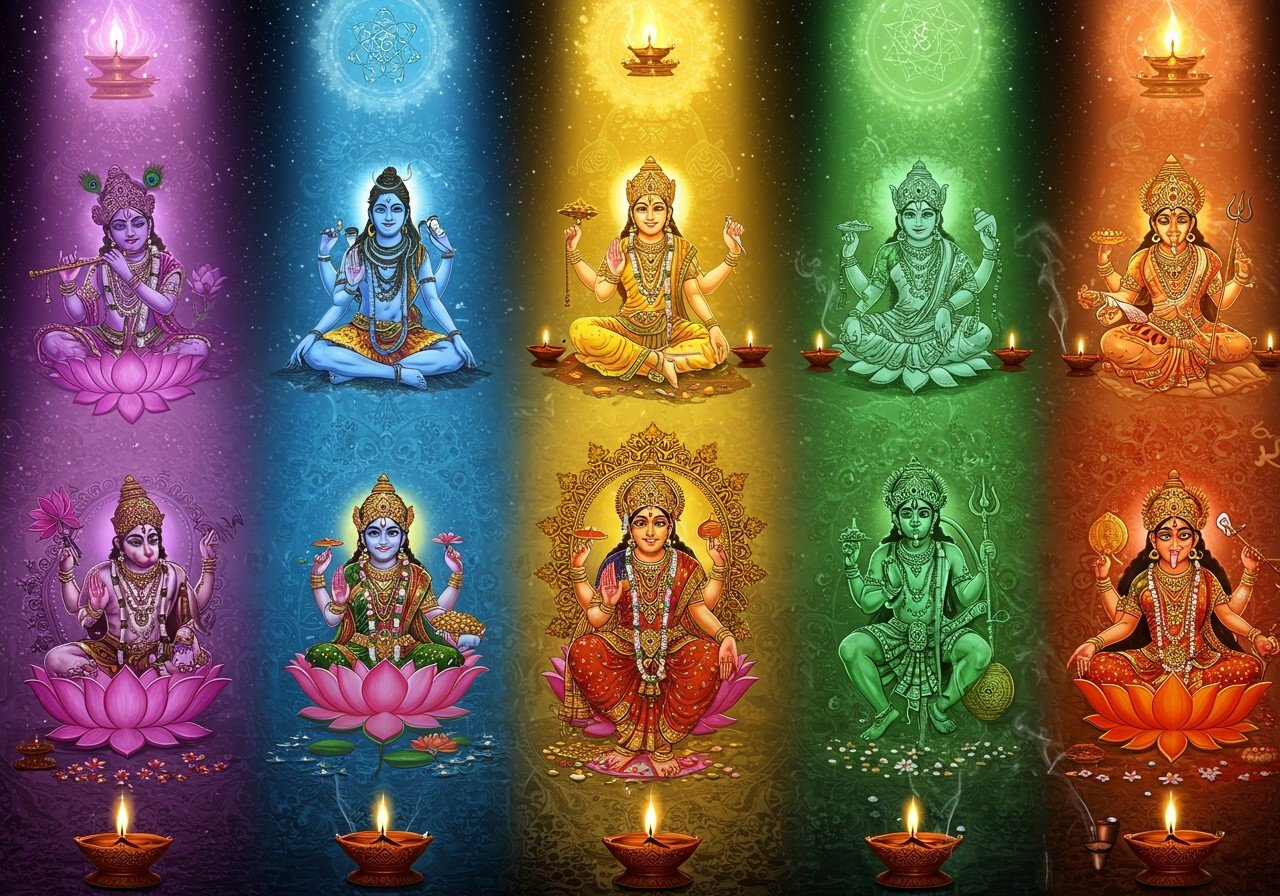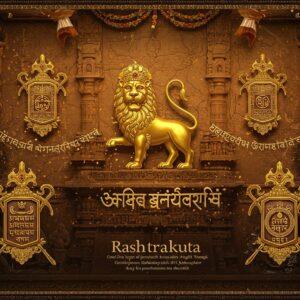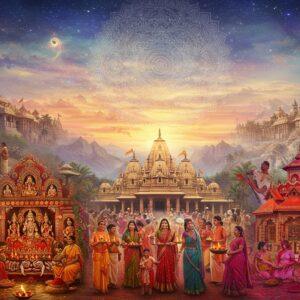
In our rich Hindu tradition, colors are far more than just visual delights; they are expressions of divinity, spirituality, and the very essence of life. They whisper stories of gods and goddesses, of emotions and qualities, weaving a vibrant tapestry that connects us to our cultural roots. These colors aren’t merely decorative; they hold profound meaning, resonating deeply with culturally rooted Indians who cherish tradition and seek authentic ritual items. Let’s explore the captivating world of Vibgyor – violet, indigo, blue, green, yellow, orange, and red – and understand their significance in Hinduism.
The Sacred Spectrum: Understanding Vibgyor
Vibgyor, mirroring the rainbow’s arc, represents divine light and cosmic harmony. Each hue in this spectrum holds a unique spiritual significance, playing a vital role in our rituals, ceremonies, and even our everyday lives. These colors often grace traditional attire, adding layers of meaning to our celebrations and spiritual practices. For those who value tradition, understanding the symbolism of Vibgyor deepens the connection to our rich cultural heritage.
Chakras: The Energy Centers and Their Corresponding Colors
In Hindu philosophy, chakras are the vital energy centers within our bodies, each resonating with a specific color from the Vibgyor spectrum. This connection highlights the deep intertwining of colors and energy flow within us.
- Muladhara (Root Chakra): Red, the color of grounding and stability, anchors us to the earth, providing a sense of security and belonging.
- Svadhisthana (Sacral Chakra): Orange, vibrant and creative, sparks our passions and fuels our artistic expression.
- Manipura (Solar Plexus Chakra): Yellow, radiating confidence and self-esteem, empowers us to shine brightly in the world.
- Anahata (Heart Chakra): Green, the hue of love and compassion, opens our hearts to connect with others and nurture deep bonds.
- Vishuddha (Throat Chakra): Blue, serene and expressive, facilitates clear communication and allows our inner voice to be heard.
- Ajna (Third Eye Chakra): Indigo, mystical and intuitive, awakens our inner wisdom and enhances our perception.
- Sahasrara (Crown Chakra): Violet, the color of spiritual connection, links us to the divine, fostering a sense of unity and enlightenment.
Vibgyor in Temple Art and Architecture
Step into any Hindu temple, and you’ll witness the vibrant presence of Vibgyor. From intricate murals and majestic sculptures to the towering gopurams (gateways), these colors narrate spiritual stories, creating an atmosphere of reverence and awe. Temples like the Meenakshi Amman Temple in Madurai are stunning examples of this artistic expression. Even the vibrant Rangoli patterns adorning our homes during festivals incorporate these sacred hues, symbolizing prosperity and harmony.
Explore more about the architectural wonders of Chhattisgarh temples.
Rituals and Festivals: A Celebration of Colors
Vibgyor colors are integral to our rituals and festivals, adding depth and meaning to our celebrations. Each color is associated with specific deities, enriching our connection to the divine. The joyous festival of Holi, a vibrant explosion of colors, celebrates renewal and the triumph of good over evil. Learn more about celebrating color and brotherhood during Holi and Raksha Bandhan. The traditional attire we wear during religious events often incorporates these sacred hues, expressing our devotion and reverence.
The Deeper Symbolism of Colors
Drawing from the wisdom of ancient texts and traditions, let’s delve into the rich symbolism associated with each color in Hinduism:
- Red: The color of love, passion, and power, red is also associated with purity and auspiciousness. It symbolizes the strength of Durga Mata and the sacred bond of marriage. From the vibrant sindoor adorning a married woman’s forehead to the red attire of a bride, this color embodies blessings and new beginnings. Find exquisite brass statues of Goddesses like Santoshi Mata at Poojn.in.
- Yellow: Representing knowledge, wisdom, and peace, yellow is associated with Lord Vishnu, Krishna, and Ganesha. It symbolizes mental development and is often worn during spring festivals, signifying new growth and spiritual awakening. Poojn.in offers a divine collection of Lord Ganesha statues.
- Green: The color of life, renewal, and nature, green symbolizes growth, prosperity, and happiness. It is often associated with festivals celebrating the arrival of spring and the bountiful harvest season. Explore the significance of sacred plants in Hindu rituals at Poojn.in.
- Blue: Symbolizing the divine, infinity, and tranquility, blue is often associated with Lord Vishnu, Krishna, and Shiva. Their blue skin represents the vastness of the cosmos and the calmness of deep meditation. Blue clothing is often worn during religious ceremonies to express devotion and spirituality. Find beautiful Hanuman ji statues at Poojn.in, representing strength and devotion.
- White: The color of purity, spirituality, and peace, white symbolizes new beginnings and the cycle of rebirth. It is often worn during funeral ceremonies and by spiritual leaders, reflecting honesty and cleanliness. Goddess Saraswati, the embodiment of knowledge, is always depicted in white.
- Saffron & Orange: Saffron, the most sacred color in Hinduism, represents sacrifice, valor, wisdom, and the quest for enlightenment. Orange, similar in its spiritual significance, represents devotion and asceticism. These colors are traditionally worn by Sadhus (ascetics), signifying a life dedicated to self-discipline and spiritual pursuit.
You can find all the products related to various colors in Hinduism and their significance at Poojn.in. Discover a complete guide to Hindu Gods and Goddesses on Poojn.in.
Connecting with Sacred Colors through Poojn.in
At Poojn.in, we understand the deep significance of colors in Hindu worship. We offer a wide selection of authentic ritual items, sourced from trusted manufacturers and temples across India, helping you connect with these sacred hues in your spiritual practices. Our knowledgeable team is always ready to assist you in selecting the perfect items for specific pujas and festivals.
Explore our collection:
- Sindoor and Kumkum (Red)
- Vastras and offerings for Lord Hanuman (Orange)
- Haldi (Turmeric) and Chandan (Sandalwood) for Lord Vishnu puja (Yellow)
- Durva grass for Lord Ganesha (Green)
- Items representing Lord Krishna and Shiva (Blue)
- Items for meditation and spiritual practices (Indigo and Violet)
- Gomti Chakra (White)
Experience the Poojn.in difference:
- Pan-India Delivery
- Secure Online Payments
- Expert Guidance
- Quality Assurance
- Authentic Items
Visit www.poojn.in, call us at 03369029784, or WhatsApp us at 9476142738.
Vibgyor in Everyday Life: A Tapestry of Tradition
Embracing Vibgyor in our daily lives is like weaving a vibrant tapestry of tradition and spirituality. Whether it’s the red sari worn for a wedding, the saffron used in meditation, or the colorful Rangoli adorning our homes, these colors connect us to our roots, adding depth and meaning to our experiences. In today’s fast-paced world, they serve as gentle reminders to pause, reflect, and cherish our rich cultural heritage. By choosing authentic ritual items online, we can effortlessly maintain these traditions, honoring the timeless connection between the physical and the spiritual.
FAQs: Delving Deeper into Vibgyor’s Significance
What is the significance of Vibgyor in Hinduism? Vibgyor represents the spectrum of colors found in a rainbow, each holding unique symbolic meaning within Hinduism, often associated with deities, energies, and chakras.
How are the Vibgyor colors linked to the seven chakras? Each Vibgyor color corresponds to a specific chakra. For instance, red is associated with the Root Chakra, while violet relates to the Crown Chakra.
What is the role of Vibgyor in Hindu temple art and architecture? Vibgyor colors are extensively used in Hindu temple art and architecture to represent various deities, spiritual concepts, and create a sacred atmosphere conducive to worship and meditation.
Why are Vibgyor colors used in Hindu rituals? Vibgyor colors are incorporated in Hindu rituals to invoke specific energies and create a vibrant connection with the divine. Each color carries a distinct vibration that influences the atmosphere of the ceremony.
Can Vibgyor colors influence mood and spirituality? Yes, Vibgyor colors can affect our mood and spiritual state. Different colors evoke various emotions and energies, fostering feelings of calm, joy, or spiritual connection. They can be powerful tools for enhancing spiritual practices.
How are Vibgyor colors used in Hindu festivals? Vibgyor colors are prominently featured during Hindu festivals through decorations, attire, and traditional practices. Their use symbolizes joy, prosperity, and the divine presence, enhancing the celebratory spirit.
Do Vibgyor colors possess a healing aspect in Hinduism? Yes, certain Vibgyor colors are believed to have healing properties in Hinduism. Each color can influence our physical, emotional, and spiritual well-being, promoting balance and harmony.


